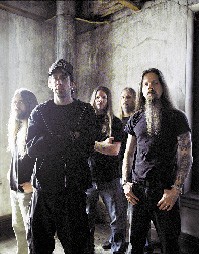 Ghoul play the Hi-Tone this Tuesday.
Ghoul play the Hi-Tone this Tuesday.
Ghoul is made up of quasi-anonymous Bay Area death metal/grindcore scene veterans that bring a refreshingly riotous sense of humor to the frequently too-serious metal scene. Taking more than a few cues from GWAR, to whom Ghoul have provided tour support in the past, the four gentlemen credited as Digestor (guitar, vocals, razor hooks and mosh riffs), Dissector (same, plus skateboards and something we’ll skip over right now), Cremator (bass, vocals, plus bone torch, something else we won’t be mentioning), and Fermentor (drums, rot gut, beserker beats) know a little something about making solid crossover thrash metal with the occasional vocal detour into the death metal arena.
But there’s so much more going on here: Ghoul’s discography of four full-length albums, last year’s six-song Hang Ten EP, and several splits with like-minded outfits (plus a 7″) provides the musical backdrop to a brilliant combination of KISS-style attention-getting tactics and new-media savviness that’s a reliable one-way ticket to amassing a cult following. The band’s elaborate fictional back-story, told lyrically throughout the progression of releases but REALLY entertaining as it comes together on their website and YouTube, stars the four band member personas as the perpetually-hooded characters they assume onstage and on record as well as a supporting cast of fellow “Creepsylvania” residents (the town’s history, as written on the site, is a must read). And to those unfamiliar or curious, the “Ask Cremator” page features four ten-minute clips (in “Ghoul’s Burning Questions” series of YouTube episodes) of the namesake member replying in advice-column style to fans who have called “the catacombs” at the number provided. Let me assure you…this is FUNNY stuff, but in no way suitable for the workplace or mixed company and perhaps only enjoyable for those with at least a passable knowledge of metal culture and history.
A couple of great things about Ghoul: Despite this degree of thematic complexity and effort, the band never slides down the slippery slope into novelty, and lastly, their sense of humor shows a mastery of subtlety and self-deprecation. For instance, perusal of Ghoul’s Bandcamp page will find a fake debut album listed simply as “Lou Reed Collaboration”. Also, it is common knowledge in the metal community that Ghoul feature (or featured) members of Bay Area death metal/grindcore bands Impaled and Exhumed. Ghoul will be headlining their Weapons of Mosh Destruction Tour when they hit the Hi-Tone on Tuesday night and it’s worth mentioning a thing or two about Phobia, who will occupy the third slot in the lineup behind Nekrofilth and local metal stalwarts Incineration. Phobia is a Southern California grindcore/crust-punk institution that formed in 1990 and has spit out countless releases over the last 25 years while going through just as many former members with the very definition of a revolving lineup. Never compromising its brutal meat-and-potatoes grind and always on the socio-political (and Anarchic) tip aesthetically and lyrically, Phobia are legends in their own right and make an interesting musical contrast to the theatrical thrash of Ghoul. This will most assuredly be a night of across-the-board metallic intensity and entertainment that doesn’t come through town all that often. Admission is $10.
